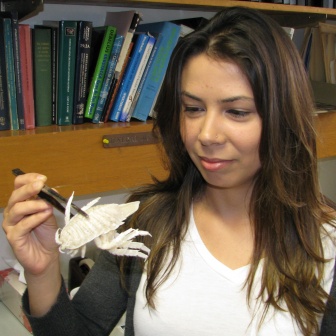
This environment was once thought to be lifeless, but four decades ago the abyss was discovered to be teeming with extremely diverse life forms. The discoveries continue today with Luana’s research, which asks the question ‘how long have these deep-sea creatures existed in this environment?’
Several studies have proposed that all animals in the world’s deep seas are periodically wiped out. The cause of these mass extinction events are anoxic (oxygen depleted) periods, thought to be triggered by climate change. The theory goes that after an anoxic period, as the oxygen levels begin again to rise, the deep seas again fill with life through recolonisation by species from the shallows. Not so, according to results published today in Biology Letters by PhD candidate Luana Lins. At least, not entirely so.
“The main finding was that the deep-sea isopods are ancient; they colonised that environment about 232-314 million years ago, and have continued to exist up until now” said Luana. If all the fauna died out in the last anoxic event, one would expect to find the oldest species a mere 90 million years old. “The results suggest that the isopods were able to survive periods when the deep sea was claimed to have no dissolved oxygen,” explained Luana. “We propose that the whole deep sea did not become anoxic; with some oxygenated refuges allowing the fauna to survive”
But how do you determine the age of a species? With a clock, of course! Luana used an age-determining methodology called ‘the molecular clock’. DNA sequences change over time. The longer ago two species evolved from a common ancestor, the more different their DNA become. Determining the rate of the DNA change can be a bit complicated, as different genes in different lineages evolve at different rates. “But,” says Luana, “an important development in the field has been the development of methods that take into account such variation in rate among lineages – known as a ‘relaxed molecular clock’.” One of Luana’s supervisors, Dr Simon Ho, has worked extensively on this method.
Luana used published and new DNA sequences to establish the relationship between different isopods and then calibrated her molecular clock with published non deep-sea fossils. Her results showed that isopods have colonised the deep sea on multiple occasions, with major groups of isopods colonising well before the anoxic periods of the Mesozoic Era (65-250 million years ago).
So, far from causing a complete extinction, some species survived, diversified and evolved despite the anoxic events. “The study shows that isopods have been in the deep sea for a long period of time,” said Luana. “This confirms the suggestion by other authors, including my co-supervisor Buz Wilson, which was based on the high number of species within some groups that are only found in deep waters.”
The results may have implications for the current climate change situation. “If another period of anoxia occurs in the deep waters, caused by an increase in the surface temperature, we cannot say whether this fauna would survive,” replied Luana cautiously. “But many other species live in the deep ocean, fish for example, that may not survive these kinds of changes.”
Read the scientific publication here:
Evidence for Permo-Triassic colonization of the deep sea by isopods
Lins, Ho, Wilson, Lo (2012) Biology Letters, 8: 979–982